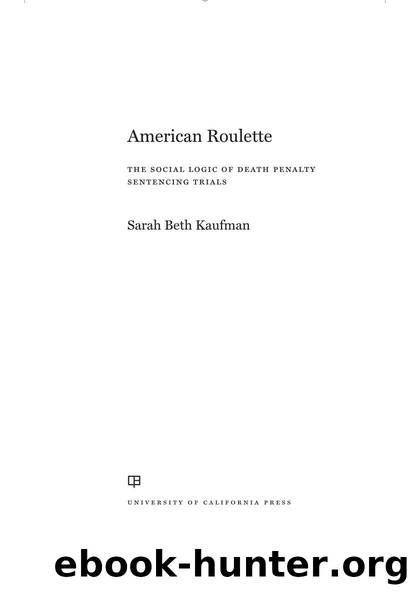American Roulette by Sarah Beth Kaufman

Author:Sarah Beth Kaufman [Kaufman, Sarah Beth]
Language: eng
Format: epub
ISBN: 9780520344389
Google: zx7TDwAAQBAJ
Publisher: Univ of California Press
Published: 2020-01-15T05:32:27+00:00
MINSKE:
Oh, yes.
DEFENSE:
And to see patients?
MINSKE:
Yes, of course.
DEFENSE:
Okay, letâs start with your rates in court. What are you paid per hour of testimony?
This goes on for the better part of an hour. Finally, and to everyoneâs visible relief, the defense attorney asks the witness to tell the jury what his testimony will focus on. Turning to face the jury, Dr. Minske speaks directly to them. He says he will first testify about the general causes of violent behavior and then how Benâs childhood fits into this. He says that he prepared for his demonstration by doing a review of current literature on the causes of violence and by interviewing the defendant and his family members, including the defendantâs mother, father, sister, and daughters. I think the jury members are beginning to warm up to Dr. Minske as they look vaguely interested in hearing what he has learned from the interviews. One nods his head, as if to agree that he wants this information.
When the attorney then asks that a projector be turned on and the familiar sound of a computer booting up is heard, the jury and audience members seem still more engaged. Turning back to the judge, Dr. Minske explains that the first part of his testimony will focus on the causes and preventive measures of violent behaviors. To the jury he says he needs to give them this information so that they can fully understand Benâs particular childhood and subsequent actions as a young adult. He says his presentation will show that Ben did not have a choice about many of the events leading up to the criminal acts that led to his conviction. He puts up the first slide. It is a brightly colored drawing of a boy standing on a wedge, sliding down into what looks like a mud pile labeled âbad act.â Suddenly, bailiffs, audience members, and jurors are all paying attention. People shift in their seats for a better view of the projection screen.
The sketch in the opening of this chapter is a replica of my notes as I followed Dr. Minskeâs slide presentation to the jurors. It is as if he is teaching schoolchildren, with simple colored shapes and arrows, and I feel him winning them over. He tells them that not everyone has the same level of moral culpability for their actions because we donât start from a level playing ground. Parents are supposed to build up protective factors that keep their children from reaching that bad act that we all want to avoid. When parents do this, there is a âwallâ between the child and any potential bad act. He says that parents can provide good modeling behavior, an intact home, and a good neighborhood with positive peer and adult influences. If they do this, the child will have a stable foundation. If, on the other hand, the parents do not provide these things, children are more likely to slide down the ramp into the morass of bad behavior. There are risk factors that make children more likely to commit bad acts, through no fault of their own.
Download
This site does not store any files on its server. We only index and link to content provided by other sites. Please contact the content providers to delete copyright contents if any and email us, we'll remove relevant links or contents immediately.
Killers of the Flower Moon by David Grann(3228)
Machine Learning at Scale with H2O by Gregory Keys | David Whiting(2264)
Will by Will Smith(2032)
Guns, Germs and Steel by Diamond Jared(1876)
Borders by unknow(1779)
The Room Where It Happened by John Bolton;(1717)
The Color of Law by Richard Rothstein(1574)
Once Upon a Broken Heart by Stephanie Garber(1471)
Water Rights and the Environment in the United States by John Burch(1412)
Examples & Explanations: Administrative Law by William F. Funk & Richard H. Seamon(1324)
Friends, Lovers, and the Big Terrible Thing by Matthew Perry(1321)
A Short History of War by Jeremy Black(1295)
Pharmacy Practice and The Law by Richard Abood(1252)
HBR's 10 Must Reads 2022 by Harvard Business Review(1251)
That Every Man Be Armed by Stephen P. Halbrook(1236)
The Strength In Our Scars by Bianca Sparacino(1234)
The Guarded Gate by Daniel Okrent(1218)
515945210 by Unknown(1205)
Injustices by Ian Millhiser(1196)
